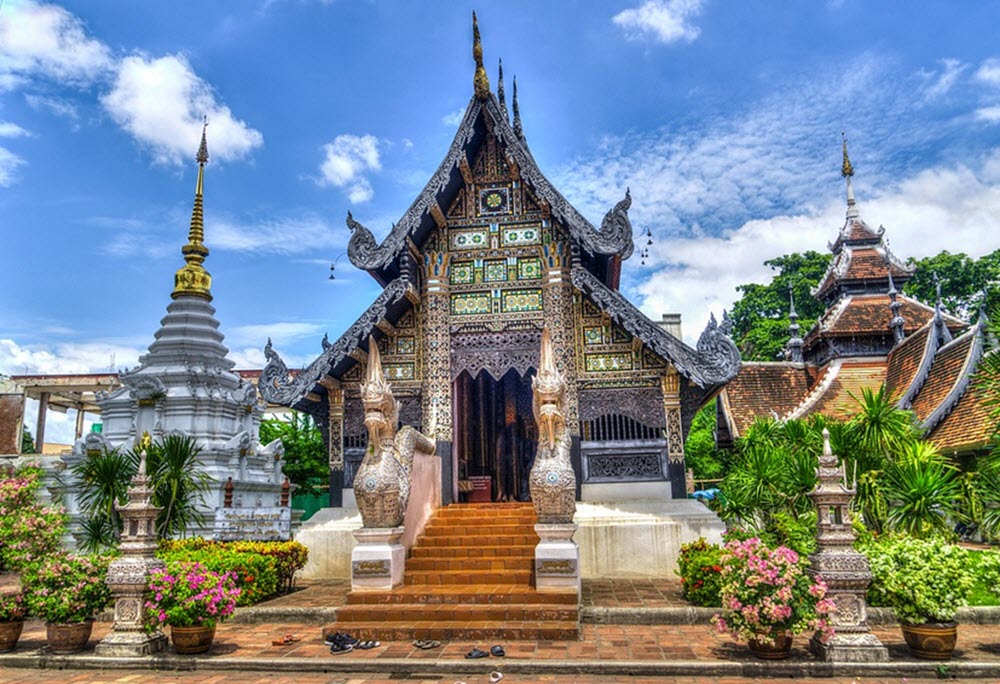In this travel guide
The Kingdom of Thailand is found on the Indochinese peninsula in South East Asia, a peninsula that also includes the countries Burma/Myanmar, Laos, Cambodia, Vietnam, and parts of Malaysia.

Thailand has been a popular tourist destination for several decades and has a well-developed tourist industry that caters to everyone, from rustic backpackers to upscale luxury visitors. The country is very popular among families travelling with small children since there are a lot of shallow kid-friendly beaches to chose among.
With an area of 513,120 square kilometres, Thailand is slightly larger than Spain. The territory is divided into 75 provinces and home to an estimated 68 million people. It is border to the south by the Gulf of Thailand and to the west by the Andaman Sea.
Thailand is a monarchy under King Vajiralongkorn (Rama X). It’s nominally a constitutional parliamentary democracy, but a coup in 2014 established a de facto military dictatorship under a junta.
The majority religion in Thailand is Buddhism; with nearly 95% of the population being Buddhists. The largest minority religion is Islam, with almost 4.5% of the population being Muslims. Other notable minority religions in Thailand are Christianity and Hinduism.
Examples of popular spots for visitors
Thailand is filled with great places to visit, and the list is by no means exhaustive.
- Ayutthaya. This UNESCO World Heritage Site is the old capital of Thailand/Siam.
- Kanchanaburi, home to the famous bridge over the River Kwai. Several WWII museums are located here.
- Chiang Mai is considered the most important city in Northern Thailand, and is the heart of the Lanna culture.
- Mae Sariang, if you want to experience hiking and small-town life near the border to Burma/Myanmar
- Khon Kaen, famous for silk production and dinosaur remains
- Khao Sok National Park, a wonderful wildlife reserve
- Khao Yai National Park with spectacular waterfalls
- Taruatao National Marine Park
- Ko Lipe, an island within the Tarutao National Park, surrounded by well-preserved reefs
- Ko Tao Island (especially popular among divers)
- The beaches of Pathio
- Ko Chang, this island is a hot-spot for beach tourism
- Khao Lak, gateway to the Similan Islands
- Ko Samui, tourism on this island used to be rustic but is now becoming more upscale
- Pattaya, a city known for its hectic nightlife.
- Ko Pha Ngan, renowned for the Full Moon Parties
Climate

The climate of Thailand is heavily influenced by two monsoons: the south-western monsoon and the north-eastern monsoon.
The south-western monsoon, which starts around mid-May and continues until mid-October, is characterised by warm, moist air that comes in from the Indian Ocean. If you visit during this monsoon season, be prepared for heavy rains over most of Thailand. August and September are the wettest month. June to early July is the driest period within the south-western monsoon season.
The north-eastern monsoon brings cold and dry air from China. It starts right after the end of the south-western monsoon and continues until mid-February. It can still rain heavily during this season despite the relative dryness of the air, but it is still a popular season for visitors from abroad. In Thailand, this season is often referred to as “winter” since the heat is less intense. Heavy rainfall is especially likely in southern Thailand, particularly in the early part of the north-eastern monsoon season (October and November).
The season between the end of the north-eastern monsoon (around mid-February) and the start of the south-western monsoon (around mid-May) is locally referred to as summer since the temperatures are very high. Days when the temperatures reach 40 °C (104 °F) are not unusual. Along the coast, the heat is a bit less oppressive due to the presence of the ocean breeze.
Is it ever cold in Thailand?
Yes, there are parts of Thailand that can get quite chilly. In the north and north-east, cold air from China can cause the temperature to drop down to the freezing point.
Cyclones
Thailand is subject to tropical cyclones, which can bring both strong winds and very heavy rainfall.
Extra rainy areas
Most parts of Thailand gets an average of 1200 mm – 1600 mm rain per year, but some places get significantly more than this. The windward sides of mountains are especially prone. The Ranong province in western Thailand, and the eastern parts of the Trat Province, are two examples of places that receive over 4500 mm of rain in an average year.
The areas with the least rain
The driest parts of Thailand are found on the leeward side of central valleys, and in the northernmost part of southern Thailand. There are places where the average annual rainfall is less than 1200 mm.

Short facts
Some basic facts about Thailand that can come in handy as you plan you trip.
- Region: South East Asia
- Official language: Thai
- Population: Over 68 million (2016 estimate)
- Capital: Bangkok (Coordinates: 13°45′N 100°29′E)
- Most populous city: Bangkok
- Currency: Baht (THB)
- Time zone: UTC +7
- Driving side: LEFT
- Calling code: +66
- ISO 3166 code: TH
- Internet top level domain: .th